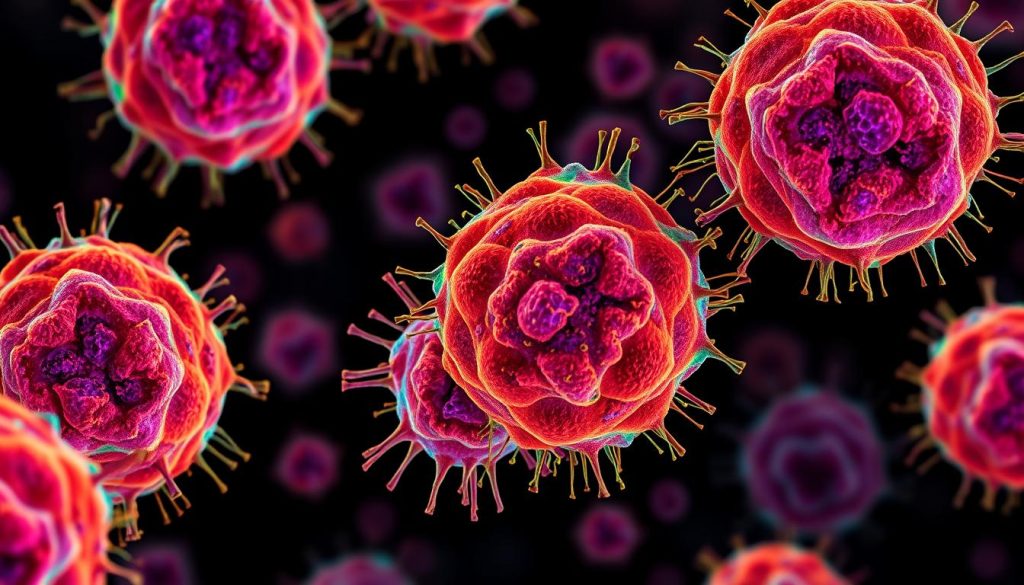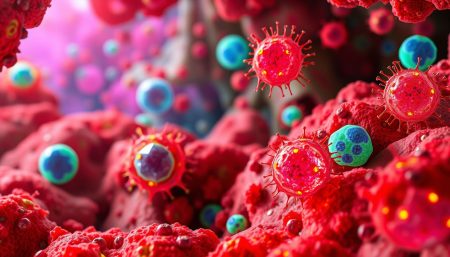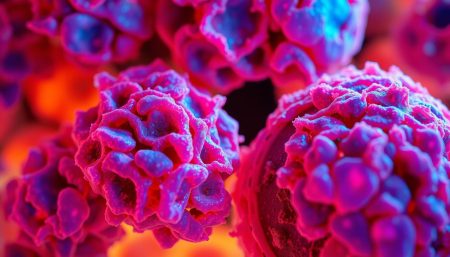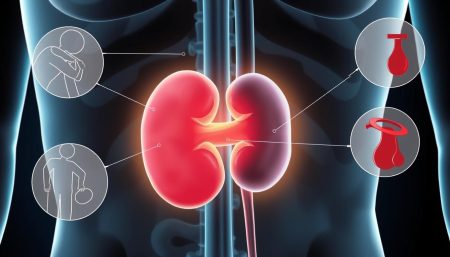Sarcoma cancer is a rare and complex group of malignancies. It affects soft tissues and bones. This disease needs special attention from oncology specialists because of its unique characteristics and treatment approaches.
Our journey through sarcoma cancer will provide valuable insights for patients, caregivers, and healthcare professionals alike. We’ll look at diagnostic procedures, treatment options, and emerging therapies. These offer hope in the fight against this rare cancer.
By understanding sarcoma’s intricacies, we can better navigate the path to effective care and improved outcomes.
Join us as we explore the complexities of sarcoma cancer. We’ll shed light on this often-misunderstood disease. We’ll also look at the cutting-edge research that’s shaping its future treatment landscape.
What Is Sarcoma Cancer: Definition and Overview
Sarcoma cancer is a rare cancer that grows in soft tissues or bones. It affects tissues like muscles, fat, blood vessels, and nerves. Knowing about sarcoma cancer is key for catching it early and treating it.
Basic Understanding of Sarcoma Formation
Sarcomas start when cells in soft tissues or bones grow too much. These cells can form tumors and spread to other parts of the body. There are two main types: soft tissue sarcoma and bone sarcoma.
Difference Between Sarcomas and Other Cancers
Sarcomas are different from carcinomas because they start in connective tissues, not organ linings. This difference changes how sarcomas grow and spread, making them stand out among cancers.
| Feature | Sarcoma | Carcinoma |
|---|---|---|
| Origin | Connective tissues | Organ linings |
| Prevalence | Rare | Common |
| Growth pattern | Outward expansion | Inward growth |
Prevalence and Risk Factors
Sarcoma cancer makes up about 1% of all adult cancers. The exact cause is not known, but some factors might raise the risk. These include genetic conditions, radiation exposure, and chemical exposure. Being aware of these can help in catching sarcoma cancer early.
Types of Soft Tissue Sarcoma
Soft tissue sarcoma is a rare cancer that affects the body’s connective tissues. It includes several subtypes, each with its own characteristics and treatment challenges.
Liposarcoma
Liposarcoma develops in fatty tissues. It often appears in the thighs or abdomen. This type of soft tissue sarcoma can grow large before causing symptoms, making early detection tricky.
Leiomyosarcoma
This cancer forms in smooth muscle tissues. It can occur in the uterus, stomach, or blood vessels. Leiomyosarcoma tends to be aggressive and may spread quickly to other parts of the body.
Synovial Sarcoma
Despite its name, synovial sarcoma doesn’t start in synovial tissue. It often develops near joints in the arms or legs. This rare cancer typically affects young adults and can be challenging to diagnose.
Angiosarcoma
Angiosarcoma forms in the lining of blood vessels. It can occur anywhere in the body but often appears in the skin, breast, or liver. This aggressive type of soft tissue sarcoma requires prompt treatment.
Understanding these subtypes helps doctors tailor treatment plans for each patient. While soft tissue sarcomas are rare cancers, knowing their unique features can lead to better outcomes and improved quality of life for those affected.
Bone Sarcoma Classifications
Bone sarcoma is a rare cancer that affects the skeletal system. In oncology, these tumors are divided into types based on their origin and characteristics. Knowing these classifications is key for accurate diagnosis and treatment planning.
The main types of bone sarcoma are osteosarcoma, chondrosarcoma, and Ewing sarcoma. Each type has its own features and affects different age groups.
| Type | Typical Age of Onset | Primary Location |
|---|---|---|
| Osteosarcoma | 10-30 years | Long bones (legs, arms) |
| Chondrosarcoma | 40-75 years | Pelvis, upper leg, shoulder |
| Ewing Sarcoma | 10-20 years | Pelvis, chest wall, legs |
Osteosarcoma is the most common type. It often starts in the bones of children and young adults. Chondrosarcoma, more common in older adults, affects cartilage cells. Ewing sarcoma, rare, can occur in bone or soft tissue, mainly in kids and teens.
These classifications help oncologists choose the best treatment. The type of bone sarcoma affects decisions on surgery, radiation, and chemotherapy.
Early Warning Signs and Symptoms
It’s important to know the early signs of sarcoma cancer. This helps in getting a diagnosis and treatment early. Sarcomas can appear in different parts of the body. So, it’s key to watch out for any unusual changes.
Common Physical Symptoms
Here are some signs to look out for:
- Unexplained lumps or swelling
- Persistent pain in bones or muscles
- Sudden weight loss
- Fatigue or weakness
- Difficulty breathing (for chest sarcomas)
When to Seek Medical Attention
If you notice any of these, don’t wait. See a healthcare professional if you have:
- A lump that grows or doesn’t go away
- Pain that gets worse over time
- Any symptom that makes daily life hard
Risk Assessment Guidelines
While anyone can get sarcoma, some things might raise your risk:
- Previous radiation therapy
- Genetic conditions like neurofibromatosis
- Exposure to certain chemicals
- Chronic lymphedema
Knowing these risk factors can help you talk to your doctor. It’s about screening and preventing sarcoma cancer.
Diagnostic Procedures for Sarcoma Cancer
Getting a correct diagnosis is key for treating sarcoma cancer well. Doctors use different tools to find out the type, grade, and stage of this rare cancer. Let’s look at the main ways to detect sarcoma.
First, doctors do physical exams. They look for lumps or unusual growths. If they think it might be sarcoma, they use imaging tests. These include:
- X-rays: Basic imaging to spot bone changes
- CT scans: Detailed cross-sectional views
- MRI: Clear soft tissue images
- PET scans: Detect cancer spread
Biopsies are very important for confirming sarcoma. A small tissue sample is taken and looked at under a microscope. There are two main types:
| Biopsy Type | Description | Best For |
|---|---|---|
| Needle biopsy | Uses a thin needle to extract cells | Smaller, accessible tumors |
| Surgical biopsy | Removes a larger tissue sample | Deeper or larger tumors |
After finding out what kind of sarcoma it is, doctors do staging tests. This tells them how far the cancer has spread. This info helps plan the treatment. Sarcoma diagnosis and treatment options keep getting better as research in oncology grows.
Staging and Grading Systems
In sarcoma cancer oncology, staging and grading systems are key. They help doctors figure out the best treatment and what to expect. These systems show how serious the disease is and how far it has spread.
TNM Classification System
The TNM system is a main tool in sarcoma cancer staging. T stands for tumor size, N for lymph node involvement, and M for metastasis. Doctors use it to see how far the cancer has spread in the body.
Grade Levels Explained
Grading in sarcoma oncology looks at how abnormal cancer cells are. Low-grade tumors grow slowly and are less likely to spread. High-grade tumors grow fast and are more likely to spread.
Stage Grouping Overview
Stage grouping uses TNM classification and grade to give a final stage to sarcoma cancer. Stages go from I to IV, with higher numbers meaning more advanced disease. This helps doctors create treatment plans and guess how well a patient will do.
| Stage | Description | Treatment Approach |
|---|---|---|
| I | Small, localized tumor | Surgery, possible radiation |
| II | Larger tumor, no spread | Surgery, radiation, possible chemotherapy |
| III | Spread to nearby tissues | Combination of surgery, radiation, and chemotherapy |
| IV | Distant metastasis | Systemic therapies, palliative care |
Knowing about these systems helps patients and families understand sarcoma cancer better. It lets them talk with their healthcare team about treatment and what to expect.
Traditional Treatment Approaches
Sarcoma cancer treatment often involves a mix of traditional methods. These methods have shown to be effective in fighting different types of sarcoma. They also help improve patient outcomes.
Surgery is the main treatment for most sarcomas. Doctors try to remove the tumor and some healthy tissue around it. This ensures all cancer cells are removed.
Radiation therapy is also key in sarcoma treatment. It uses high-energy beams to shrink tumors or kill cancer cells left after surgery. Some patients get radiation before surgery to make it easier to remove the tumor.
Chemotherapy is another important part of treating some sarcomas. This treatment uses drugs to kill cancer cells all over the body. It’s mainly used for high-grade or spread-out sarcomas.
Many patients get a mix of these treatments. This multi-modal approach attacks cancer from different sides. For example, a patient might have surgery, then radiation therapy and chemotherapy.
- Surgery: Removes visible tumors
- Radiation therapy: Targets localized cancer cells
- Chemotherapy: Fights cancer throughout the body
While these treatments work well, they can cause side effects. Patients might feel tired, nauseous, or have changes in appetite. Your medical team will help manage these side effects. They aim to keep your quality of life good during treatment.
Advanced Surgical Techniques
Sarcoma cancer treatment has made big strides in surgery. New methods aim to remove tumors while keeping function and improving life quality. Let’s look at some of these new approaches in oncology.
Limb-Sparing Surgery
Limb-sparing surgery is a big leap forward in sarcoma treatment. It lets surgeons take out tumors without cutting off the limb. By removing the cancer and some tissue around it, doctors can often save the arm or leg.
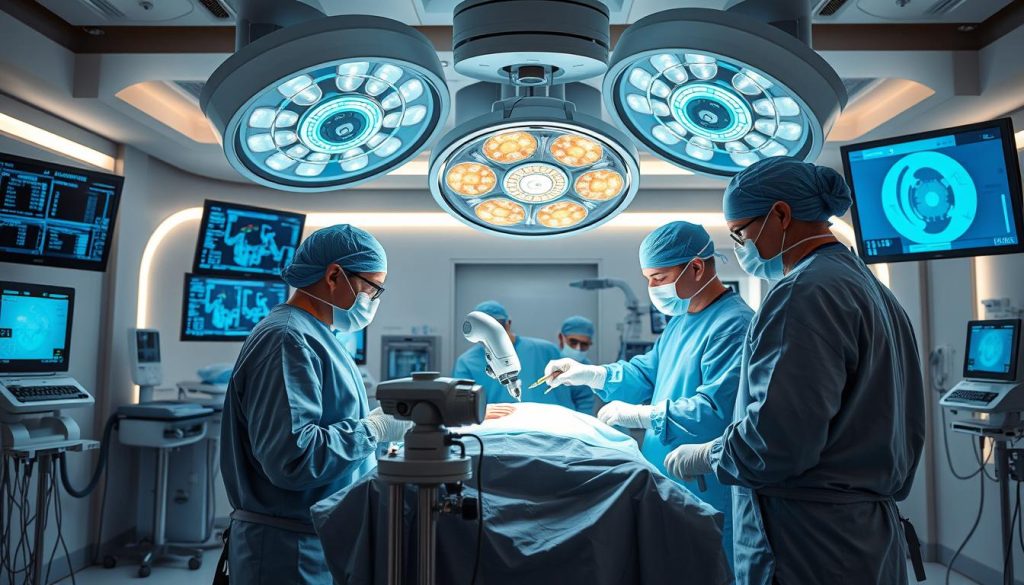
Reconstructive Options
After removing the tumor, rebuilding is key. Surgeons use different ways to fix damaged areas:
- Bone grafts
- Prosthetic implants
- Tissue transfers
- 3D-printed implants
These methods help restore shape and function. They let patients move better and feel more confident.
Recovery and Rehabilitation
Recovering well after surgery is essential. Patients usually follow a special rehab plan that includes:
| Rehabilitation Component | Purpose |
|---|---|
| Physical therapy | Restore strength and range of motion |
| Occupational therapy | Improve daily living skills |
| Pain management | Control discomfort and promote healing |
| Psychological support | Address emotional challenges |
These advanced surgical methods and full care plans have changed sarcoma cancer treatment. They offer patients better results and a better life quality.
Radiation Therapy Protocols
Radiation therapy is a key part of treating sarcoma cancer. It uses high-energy rays to kill cancer cells. Doctors might suggest it before or after surgery, based on the tumor’s size and where it is.
There are two main types of radiation therapy for sarcomas:
- External beam radiation: This sends radiation from a machine outside the body
- Brachytherapy: This places radioactive material directly into or near the tumor
External beam radiation is more common. It involves daily treatments over several weeks. Brachytherapy is used in some cases, like for soft tissue sarcomas.
The timing of radiation therapy can vary. Preoperative radiation tries to shrink tumors before surgery. Postoperative radiation kills any cancer cells left after surgery. Your doctor will decide the best time for you.
Side effects of radiation therapy include:
- Skin irritation
- Fatigue
- Swelling in the treatment area
Your healthcare team will help you manage these side effects. They might suggest skin care products, rest, and gentle exercises to help you during treatment.
Radiation therapy is effective in controlling tumor growth. It can greatly improve results when used with surgery and other treatments. New techniques are being developed to make radiation more precise and reduce side effects.
Chemotherapy Regimens and Management
Chemotherapy is a key part of cancer treatment, including sarcomas. It uses drugs to kill cancer cells everywhere in the body. Let’s look at the main points of chemotherapy for sarcoma patients.
Common Drug Combinations
Doctors often mix different drugs to fight sarcoma. These mixes aim to hit cancer cells from various angles. Some common combinations include:
- Doxorubicin and Ifosfamide
- Gemcitabine and Docetaxel
- Vincristine, Dactinomycin, and Cyclophosphamide
Side Effect Management
Chemotherapy can lead to side effects. Patients might feel tired, sick, or lose their hair. Doctors work hard to manage these issues. They might give medicines to reduce nausea or boost blood cell counts. Eating well and getting rest also helps.
Treatment Cycles
Chemotherapy is given in cycles. Each cycle lasts 3-4 weeks. Patients get the drugs, then rest to recover. The number of cycles depends on the sarcoma type and stage.
| Cycle Phase | Duration | Activity |
|---|---|---|
| Treatment | 1-5 days | Receive chemotherapy drugs |
| Rest | 2-3 weeks | Body recovers, side effects managed |
| Evaluation | 1 day | Check progress, adjust if needed |
Understanding chemotherapy can help patients feel more ready for their cancer treatment. Always talk to your doctor about any concerns or questions you have about your specific treatment plan.
Emerging Targeted Therapies
Targeted therapy is changing how we treat cancer, including sarcomas. These new drugs focus on specific ways tumors grow. They aim to be more effective and have fewer side effects.
Recent breakthroughs in targeted therapy for sarcoma include:
- Tyrosine kinase inhibitors
- mTOR inhibitors
- PARP inhibitors
- Immunotherapy agents
These therapies are showing great promise in treating different sarcoma types. They offer new hope for patients who haven’t responded to traditional treatments.
| Targeted Therapy | Sarcoma Type | Mechanism |
|---|---|---|
| Imatinib | Gastrointestinal stromal tumors | Inhibits KIT and PDGFRA mutations |
| Pazopanib | Soft tissue sarcomas | Blocks multiple kinases |
| Tazemetostat | Epithelioid sarcoma | Targets EZH2 protein |
Research is ongoing to find new targets and improve therapy combinations. As we learn more about sarcoma biology, we’re getting closer to more personalized and effective treatments.
Clinical Trials and Research Updates
Clinical trials are key in finding new ways to treat sarcoma cancer. They test new treatments and approaches to help patients live better lives.
Current Studies
Today, trials focus on targeted therapies, immunotherapies, and personalized medicine. Scientists aim to make treatments work better and have fewer side effects.
| Trial Type | Focus Area | Potential Benefits |
|---|---|---|
| Immunotherapy | Boosting immune response | Improved tumor recognition |
| Targeted Therapy | Specific genetic mutations | Reduced systemic effects |
| Combination Therapy | Multiple treatment approaches | Enhanced overall efficacy |
Participation Criteria
To join a trial, you must meet certain criteria. This includes your cancer type, stage, and past treatments. Talk to your doctor to see if you qualify. Trials have rules to keep patients safe and ensure the study’s success.
Future Treatment Directions
The future of sarcoma treatment is exciting. Scientists are looking into gene therapy and nanotechnology. These new methods could lead to more precise and less invasive treatments, changing how we care for patients.
Support and Recovery Resources
Dealing with sarcoma cancer is more than just medical treatments. Patients and their families need all-around support to face the challenges of this rare cancer. The oncology community knows that caring for the whole person is key in sarcoma recovery.
Support groups are vital in the healing journey. They let patients meet others who understand their struggles. Sharing stories can offer emotional comfort and practical advice for living with sarcoma cancer.
Counseling services provide professional help to deal with the emotional side of diagnosis and treatment. Trained therapists in oncology can help patients manage their feelings and find ways to cope.
Rehabilitation programs are key for physical healing. These might include:
- Physical therapy to build strength and move better
- Occupational therapy for adjusting to daily tasks
- Speech therapy if treatment changed how you talk
Many hospitals and cancer centers have these resources as part of their sarcoma care. Patients should talk to their oncology team about what’s available to help with their recovery plan.
| Resource Type | Benefits | Availability |
|---|---|---|
| Support Groups | Emotional support, shared experiences | Local hospitals, online communities |
| Counseling Services | Professional mental health support | Cancer centers, private practices |
| Rehabilitation Programs | Physical recovery, improved function | Specialized clinics, outpatient services |
Living with Sarcoma: Quality of Life Considerations
Sarcoma cancer, a rare cancer type, affects daily life in many ways. Patients face unique challenges as they adapt to life during and after treatment. This section explores key aspects of living with sarcoma and maintaining quality of life.
Physical Adaptations
Sarcoma often affects mobility and physical function. Patients may need to adjust their routines and living spaces. Some common adaptations include:
- Using mobility aids like canes or wheelchairs
- Modifying home layouts for easier access
- Engaging in physical therapy to improve strength and flexibility
Emotional Support
The emotional toll of sarcoma cancer can be significant. Patients often benefit from various forms of support:
- Counseling or therapy sessions
- Support groups for sarcoma patients
- Family and friend networks
These resources help patients cope with anxiety, depression, and other emotional challenges. Understanding different cancer types can also provide valuable perspective and support.
Long-term Outlook
The long-term outlook for sarcoma patients varies. Factors influencing prognosis include:
| Factor | Impact on Outlook |
|---|---|
| Stage at diagnosis | Earlier stages generally have better outcomes |
| Tumor location | Affects treatment options and possible complications |
| Response to treatment | Positive responses improve long-term prognosis |
Many sarcoma survivors lead fulfilling lives post-treatment. Regular follow-ups, maintaining a healthy lifestyle, and staying informed about new developments in rare cancer research contribute to long-term well-being.
Prevention and Risk Reduction Strategies
Sarcoma cancer is rare, but you can lower your risk. Eating well, staying active, and avoiding tobacco are important. These habits help keep you healthy.
Try to avoid harmful chemicals and radiation. If you work in risky jobs, wear protective gear. Also, seeing your doctor regularly can help catch problems early.
Know your family’s health history. If cancer runs in your family, talk to your doctor. They might suggest more tests or ways to prevent it. Taking care of your health doesn’t mean you won’t get sarcoma. But it can make you feel better overall.
FAQ
Q: What is sarcoma cancer?
A: Sarcoma cancer is a rare cancer that grows in the body’s connective tissues. This includes bones, muscles, tendons, and fat. It’s different from more common cancers because it can appear anywhere in the body. Sarcomas are split into soft tissue and bone sarcomas.
Q: How common are sarcomas?
A: Sarcomas are quite rare. They make up about 1% of adult cancers and 15% of childhood cancers. There are over 50 different types of sarcoma, each needing its own treatment.
Q: What are the main types of soft tissue sarcomas?
A: Common soft tissue sarcomas include liposarcoma, leiomyosarcoma, synovial sarcoma, and angiosarcoma. Each type has its own features and treatment plans.
Q: What are the main types of bone sarcomas?
A: Bone sarcomas include osteosarcoma, chondrosarcoma, and Ewing sarcoma. These cancers can grow in different parts of the bones. They often need special treatments.
Q: What are the early warning signs of sarcoma?
A: Early signs of sarcoma include a painless lump, bone pain, unexplained weight loss, and fatigue. For soft tissue sarcomas, a growing mass is often the first sign. If you notice anything unusual, see a doctor.
Q: How is sarcoma diagnosed?
A: Diagnosing sarcoma involves a physical exam, imaging tests, and a biopsy. The biopsy is key to finding out the type and grade of sarcoma. This information helps decide the treatment.
Q: What treatment options are available for sarcoma?
A: Sarcoma treatment often involves surgery, radiation, chemotherapy, and targeted therapies. The best plan depends on the sarcoma’s type, location, and stage, and the patient’s health.
Q: What is limb-sparing surgery?
A: Limb-sparing surgery aims to remove tumors while keeping the limb. It’s a complex procedure that may include reconstruction and radiation therapy.
Q: Are there new treatments being developed for sarcoma?
A: Yes, new treatments for sarcoma are being researched. Targeted therapies and immunotherapies are being explored. Clinical trials are testing new drugs and treatments to improve outcomes and reduce side effects.
Q: What support resources are available for sarcoma patients?
A: Many support resources are available for sarcoma patients and their families. This includes support groups, counseling, rehabilitation, and educational resources. Hospitals also offer dedicated services for sarcoma patients.
Q: Can sarcoma be prevented?
A: While prevention is not always possible, some strategies can help. Avoiding radiation and certain chemicals, staying healthy, and knowing your family cancer history can reduce risk.












